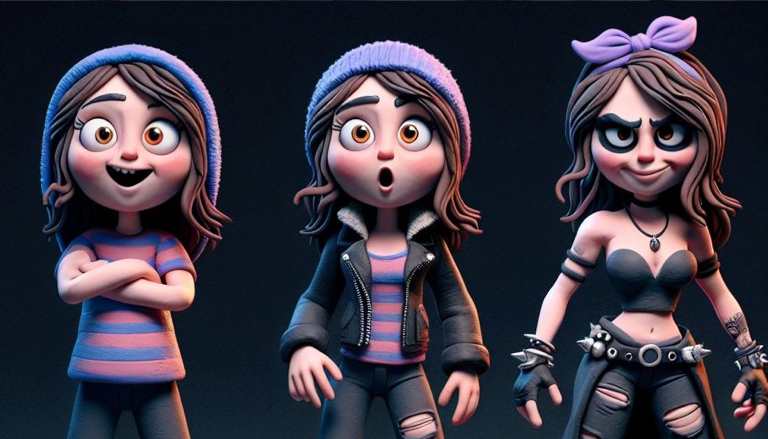A character arc is the transformation characters undergo in a story, evolving from who they are at the beginning to who they become at the end.
The shy farmer who grows into a brave warrior, the cold and calculating executive who ends up falling in love with her tender assistant, the ordinary person with a boring life who becomes a hero … The character arc is a journey that takes a character from point A (the beginning of the plot) to point B (the end of the plot) and it is a crucial part of any character profile template.
What is a Character Arc For?
A character arc contributes a lot to any story, but if I had to stick with two specific functions, I would say that they are to enhance the theme and make the characters more interesting. A good character arc is the best way to create round characters.
The character arc helps to enhance the theme because the character learns a valuable lesson related to this theme. For example, in The Count of Monte Cristo, Edmond Dantes is obsessed with getting revenge on those who betrayed him. He conspired his entire life around that revenge and went a long way to achieve it. However, his plan to take revenge on his enemy’s son generates a great internal conflict for him after getting to know the boy better and taking a liking to him. Finally, Edmond leaves the path of revenge behind and decides to seek happiness elsewhere, growing as a person and teaching us readers a moral. It is a much more impactful and effective way of showing us the story’s theme than if the author told us that revenge does not bring happiness.
Additionally, Edmond’s character becomes more appealing thanks to this arc. A character who changes, to whom things happen, who learns and evolves is a character with whom it is easier for us to identify. When we immerse ourselves in a story, we want to grow with the characters and take a “virtual” journey that returns us changed to the real world.
🎓 Learn more: How to Write Character Descriptions — Guide and Examples
What types of character arcs exist?
When we talk about types of character arcs, we can find different classifications. Most authors tell us about three types of character arcs, others about four and some even about five or six. I prefer to organize character arcs by level and category:
- Character arc levels: Inner and Outer.
- Character arc categories: Positive, Negative and Static.
Why do I prefer this classification? Because we can mix them with each other. For example, a character can have a positive inner arc and a negative outer arc at the same time. But we will see this later. First, I would like to explain in more detail the different types of character arcs according to their classification.
Character Arc Levels
The first and most obvious classification that we can make of a character arc is that of the outer and inner levels. The inner evolution of a character is a moral, values, ideological, or psychological transformation. The outer evolution consists of an external transformation of the character, the things that change in their life through the story.
Although sitcoms usually have characters with flat arcs, let’s take Chandler’s character in the sitcom Friends as an example since he had an inner and outer evolution throughout the ten seasons of the series.
Internally, Chandler began the series as an immature, somewhat cynical and afraid of commitment guy. But in the last chapter, he had become a committed, sensitive, and responsible family man.
On an external level, Chandler is initially a single man who lives with a friend and has a boring job. At the end of the series he was married, had two children, and had a creative job.


Character Arc Categories
Regardless of the inner or outer level of a character arc, there are three different classifications when we talk about character arcs: Positive Arc, Negative Arc, and Static Arc.
Positive Character Arc
The positive character arc is the arc in which the character becomes someone better. The character evolves from a bad situation to a good one, or better than the initial one. It is the character arc of stories with a happy ending.
The hero who manages to defeat the evil villain, the kids who get their parents back together, the time traveler who manages to return home after undoing the wrongs of the past… Cinema and literature are full of examples of arcs of love. positive character.
Negative Character Arc
On the opposite side is the negative arc. In this case, the character evolves from a good situation to a worse one, or becomes worse internally. Anakin Skywalker in Star Wars is a good example for the negative character arc, both internally and externally. Anakin goes from being a handsome Jedi with positive convictions to a monster who has to hide under a mask and only feels hatred and resentment.
Static Character Arc
Static arc, also known as the Flat Character Arc, is actually a non-arc, since there is no evolution in the story. The character starts and ends the same way. Characters with a static arc are called static characters and it is one of the characteristics of flat characters. Although not all characters with a flat arch are flat!
A well-known example of a Flat Character Arc is Sherlock Holmes since he is the protagonist of a plot-driven story. What matters in Holme’s novels is how he solves the mystery, rather than how the plot affects the character.
🎓 Learn more: Flat characters do not change during the story, but they are also two-dimensional. Static characters do not change during the story either, but they can have motivations, dilemmas, and complexities.
How many character arcs can there be in a story?
As many as history needs. Not only do protagonists have character arcs, antagonists, deuteragonists, and other supporting characters can also have their own arc. But also, the same character can have more than one character arc if the story requires it.
For example, a main character whose arc evolves from a bad relationship with their parents to a good relationship thanks to what he learns in the plot. At the same time, he goes through another arc in which he goes from being a successful and wealthy lawyer to a reviled and bankrupt person without a job who has lost his license. Those are two very different arcs, but both can coexist in the same story.
Plus, the combinations are endless. A character can have a positive inner arc and a negative outer arc, and vice versa. It may even occur that there is no evolution at one level, but there is at another. For example, in the case of Leia in Star Wars: she has a flat arc internally since she does not change how she thinks and behaves. However, on an external level, she does change, since she finds her lost brother and starts a relationship with Han Solo.
What Role Does Plot Play in Shaping a Character Arc?
Like so many other elements in a story, character arcs and plots are not isolated elements. They depend on each other. When we encounter a positive or negative character arc, the characters’ motivation and their evolution in the story run parallel to the plot.
It does not mean that the plot and character arc are the same. We can have a plot that affects two characters, but they have different arcs. For example, the love story between Han and Leia is a subplot within the first Star Wars film. However, Leia is only affected on an external level. She goes from being single to starting a relationship with Han. Han does change on an external and internal level. What he feels for Leia makes him change his character, his beliefs, and her way of life.
How Can We Create a Compelling Character Arc?
For a character arc to work, it must be both believable and satisfying for the reader. We have to take care of how the transformation occurs, and we have to fulfill the character arc promises we make to the reader.
The promise of a character arc happens when we introduce the character: it is then when we reveal what is missing in their life, what they desire, and what obstacles stand in their way. We promise the reader that by the end of the story, we will address the questions: Will they achieve their desires? Can they overcome the obstacles? How will this journey impact the character?
As for the transformation, it must be gradual. We cannot make the character change suddenly and for no reason. We have to sow it step by step, from the beginning to the revelation moment in which the character changes. And the change must always be credible and justified.
It helps to make a list of the most relevant plot points and reflect on how they will affect the character arc. What changes, obvious or subtle, will occur little until the point of no return?
🎯 Pro Tip: Try planning your character arcs backward. Start by asking yourself what will be satisfactory. What is the topic you want to highlight? What is the best ending for this story? When you have the answer, you could try building the character arc backward with the following plot points:· Beginning· Inciting Incident· Rising Action· Largest Obstacles· Loss of Hope· Climax· Resolution
Where Can You Find Inspiration for a Character Arc?
If you have followed all the previous points and you still do not know how to create your character arc, there are some tips that may help you:
Follow The Story Theme
If you know the themes of your story, it will be easier to find what the character arc should be like in any of the plots or subplots. If you want to convey that friendship is more important than romantic love, you should use that thought in some of your character arcs. Show what happens to those who go against this idea and have the protagonist evolve from the misbelief that romantic love is above all, to the belief that friendship is the most important thing.
Attack the characters in their flaws
A well-rounded character should have a flaw that directly links to the theme of the story and affects the plot. It is another obstacle in their way to achieve the goal. Think about how they might deal with these obstacles and whether or not they will be able to overcome their flaws. Will they be strengthened? Will they come out of the battle badly? The answer is your character arc.
Do Not Neglect Your Character Arcs
As you have seen, the character arc is a fundamental part of any story. A good character arc will help you create compelling characters, deeper stories, and more immersive themes. Dedicate the necessary time to crafting your character arcs so that they have the correct evolution, and your story will be stronger!
